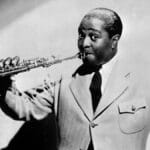Stan Getz, the jazz icon whose saxophone melodies have enchanted audiences for decades, holds a unique place in the history of American music. This article delves into intriguing facets of his life and career, exploring the experiences that shaped his signature sound and cemented his legacy as a jazz legend. From his early beginnings to his groundbreaking collaborations, Getz’s story is a captivating blend of talent, passion, and enduring influence.
Facts About Stan Getz: Getting Hip to “The Sound”
Stan Getz, born in Philadelphia in 1927, wasn’t simply a saxophone player; he was a musical force. He wasn’t content with mastering just one genre; his influence spanned bebop, cool jazz, and bossa nova. His smooth and lyrical approach to the tenor saxophone earned him the moniker “The Sound,” a testament to the instantly recognizable nature of his playing.
From Philly to Jazz Star
Getz’s musical journey began at the tender age of 13, showcasing a natural affinity for the saxophone. His early years were steeped in the world of bebop and cool jazz, genres that would heavily influence his evolving style. By 16, his talent was evident, landing him a coveted spot in Jack Teagarden’s band.
The Coolest Cat in Jazz
The 1950s saw Getz deeply immersed in the burgeoning cool jazz scene. He collaborated with some of the era’s biggest names, including Woody Herman, with whom he played in Herman’s renowned “Second Herd.” This period saw Getz further solidifying his reputation as a rising star and a master of cool jazz’s relaxed and introspective style.
Bossa Nova and Beyond
Getz’s musical curiosity knew no bounds. In the 1960s, he helped introduce the world to bossa nova, a then-emerging Brazilian genre. His collaboration with Brazilian artists like João Gilberto and Antônio Carlos Jobim led to the iconic recording of “The Girl from Ipanema,” a song that would become synonymous with bossa nova and propel Getz to international stardom.
A Musical Teammate and Award Winner
Throughout his career, Getz embraced collaboration, playing with an impressive roster of musicians. From jazz legends like Dizzy Gillespie and Oscar Peterson to vocalists like Nat King Cole and Astrud Gilberto, Getz’s ability to blend his unique voice with others resulted in some of the most memorable recordings in jazz history.
His immense talent didn’t go unnoticed. Getz was the recipient of numerous accolades, including several Grammy Awards, and was inducted into the Grammy Hall of Fame, cementing his legacy as one of jazz’s most celebrated figures.
Keeping the Music Alive
Stan Getz’s impact on music transcends his lifetime. His recordings continue to inspire and influence musicians across generations and genres. His innovative spirit, technical mastery, and ability to infuse emotion into every note ensure that the legacy of “The Sound” continues to resonate within the world of jazz and beyond.
What are some fun facts about Stan Getz?
Beyond the accolades and critical acclaim, Stan Getz’s life was punctuated by fascinating anecdotes and unexpected tidbits that offer a glimpse into the man behind the music.
A Musical Upbringing, With a Twist
Getz’s passion for music revealed itself early on, though not always in conventional ways. Legend has it that a young Getz, full of mischief, turned his sister’s piano into his personal drum set, showcasing an innate sense of rhythm and a playful energy that would later translate into his spontaneous performances.
The “Stan Getz Sandwich”
Getz’s signature saxophone style, characterized by its smooth, lyrical quality, garnered immense popularity. Some jazz clubs even went so far as to create a tribute: the “Stan Getz Sandwich.” Contrary to what one might expect, this “sandwich” wasn’t a culinary creation but rather a glass of water and a bar napkin adorned with Getz’s autograph – a testament to the allure of his unique sound.
“The Girl from Ipanema”: A Happy Accident?
The recording session for “The Girl from Ipanema” resulted in one of the most iconic jazz vocals of all time, but it also involved an intriguing twist. It’s said that Getz was particularly taken with Astrud Gilberto’s Portuguese accent, believing it lent an authentic charm to the song. He insisted she be featured more prominently, and the rest, as they say, is history.
A True Professional, Even in the Face of Mishaps
Getz’s composure on stage was legendary, as evidenced by a tale involving a broken saxophone reed mid-performance. While most musicians would understandably panic in such a situation, Getz calmly switched to his backup saxophone and continued playing without missing a beat, showcasing the mark of a true professional.
Overcoming Adversity
Getz’s life, like the lives of many artists, wasn’t without its challenges. He battled personal demons, including drug addiction. However, he confronted these struggles head-on, becoming an advocate for rehabilitation and recovery. His story serves as a reminder that even in the face of adversity, hope and second chances are possible.
A Life in Collaboration
Collaboration was a cornerstone of Getz’s musical journey. His ability to seamlessly blend his unique voice with others resulted in groundbreaking partnerships with some of the biggest names in jazz. From the rhythmic genius of Dizzy Gillespie to the harmonic complexities of Oscar Peterson, Getz’s collaborations enriched the jazz landscape and expanded the boundaries of the genre.
The Bossa Nova King
Getz played a pivotal role in popularizing bossa nova, a Brazilian musical style celebrated for its infectious rhythms and mellow vibes. His collaborations with Brazilian artists brought this genre to a global audience, earning him the affectionate title “The Bossa Nova King.”
Stan Getz’s life was a tapestry woven from musical innovation, personal struggles, and a deep passion for his craft. He was a musical chameleon, effortlessly moving between genres while always maintaining the essence of his signature sound. He was a survivor, confronting his demons with the same courage and determination he brought to the stage. And most importantly, he was an artist who, through his music, continues to touch the hearts and souls of listeners worldwide.
What was Stan Getz’ nickname?
Stan Getz’s nickname, “The Sound,” perfectly encapsulated the essence of his musical identity. It wasn’t merely a catchy moniker; it was a testament to the singular nature of his saxophone playing – a sound so distinctive, so instantly recognizable, that it transcended mere description.
The Making of “The Sound”
Getz’s signature sound wasn’t something he stumbled upon; it was the result of years of dedicated practice, a deep understanding of his instrument, and a willingness to experiment. He drew inspiration from saxophone greats like Lester Young, known for his own mellow and soulful approach. This influence, combined with Getz’s innate talent and tireless work ethic, contributed to the development of his trademark sound.
The “Four Brothers” and a Defining Era
Getz’s time with Woody Herman’s “Second Herd” proved pivotal in shaping his career and further solidified his reputation as a master of “The Sound. He was part of a saxophone section dubbed “The Four Brothers,” known for their remarkable blend and intricate harmonies. This period saw Getz honing his skills alongside other talented saxophonists, further refining his own voice within the context of a larger ensemble.
Beyond Bebop and Cool Jazz
While Getz’s roots lay in bebop and cool jazz, he always sought new avenues for musical exploration. His openness to new sounds led him to embrace bossa nova, a then-relatively unknown genre from Brazil. Getz’s collaborations with Brazilian artists not only introduced this captivating style to a global audience, but also added another layer of depth and nuance to his already impressive musical palette.
Stan Getz’s nickname, “The Sound,” served as a shorthand for his unique musical identity, yet it only scratched the surface of his multifaceted contributions to jazz. He was a master of melody, a skilled improviser, and a fearless innovator who refused to be confined by genre conventions. “The Sound” of Stan Getz continues to resonate throughout the world of jazz, a testament to the enduring power of his musical vision.
How Popular Was Stan Getz?
Stan Getz’s popularity extended far beyond the confines of the jazz world. He achieved a level of recognition that transcended genre, captivating audiences with his smooth saxophone melodies and his ability to seamlessly blend musical styles.
“The Sound” that Resonated with Millions
Getz’s nickname, “The Sound,” hints at the broad appeal of his music. His playing possessed a unique quality, a warmth and lyricism that resonated with listeners who might not have considered themselves jazz aficionados. His willingness to explore different styles, from the energy of bebop to the laid-back vibes of cool jazz and the exotic rhythms of bossa nova, broadened his appeal and solidified his status as a versatile and innovative musician.
“The Girl from Ipanema”: A Global Phenomenon
Getz’s 1964 recording of “The Girl from Ipanema,” a collaboration with Astrud Gilberto and Antônio Carlos Jobim, became a global sensation. The song transcended cultural boundaries, introducing bossa nova to a massive international audience and solidifying Getz’s place in the annals of popular music history.
A Musical Mentor and Prolific Collaborator
Getz’s impact went beyond his own fame. He was generous with his knowledge and passionate about nurturing young talent. His career spanned decades and encompassed over 100 albums, showcasing his incredible range and influencing countless artists across multiple generations.
Measuring the Impact
Quantifying Getz’s popularity in concrete terms is a complex task. His influence extended beyond chart positions and record sales. He was a musician’s musician, respected by his peers for his technical mastery and his dedication to his craft. He was a cultural icon whose music soundtrack the lives of millions, leaving an indelible mark on the jazz world and beyond.
Stan Getz’s music continues to enchant listeners today. He’s remembered not just for his virtuosity but also for the emotional depth he poured into every note. His legacy as a jazz legend is undeniable, and his music continues to inspire new generations of musicians, ensuring that “The Sound” remains an integral part of the jazz lexicon.
How Much Did Stan Getz Practice?
Stan Getz’s mastery of the saxophone was not solely the result of innate talent; it was also a testament to his unwavering dedication and rigorous practice regimen. Imagine a young Getz, saxophone in hand, completely absorbed in his craft for eight hours every single day. This intense dedication formed the foundation of his exceptional skill and his reputation as “The Sound,” a nickname earned through countless hours of honing his craft.
Beyond Clocking In: The Pursuit of Mastery
Getz’s commitment to practice extended beyond merely putting in the hours. It was about deep immersion, a relentless pursuit of perfection, and a constant exploration of the saxophone’s sonic possibilities. This dedication allowed him to master not just one, but multiple saxophones, with the tenor saxophone ultimately becoming his primary instrument of choice.
The Art of Improvisation
Getz wasn’t content with simply replicating what others had done before him. He was captivated by improvisation, by the ability to create music spontaneously and express himself in the moment. Those countless hours of practice provided him with the technical foundation and the improvisational vocabulary to navigate the complex harmonic progressions and rhythmic intricacies of jazz.
A Natural Talent, Honed by Discipline
Remarkably, Getz achieved this level of mastery with minimal formal music theory training. While his natural talent was evident, it was his unwavering discipline, his willingness to devote himself fully to his craft, that elevated him to the pantheon of jazz greats. His story is a powerful reminder that while talent might provide the initial spark, it’s dedication, perseverance, and countless hours of focused practice that truly ignite the flame of mastery.
Reflecting on Dedication and Mastery
Stan Getz’s journey offers valuable insights into the nature of talent and the transformative power of dedication. His story prompts us to consider:
- The significance of consistent effort in achieving mastery, regardless of the field.
- The role of passion and discipline in transforming natural ability into exceptional skill.
- The importance of embracing challenges and pushing beyond one’s comfort zone to achieve true artistic growth.
Stan Getz’s legacy extends far beyond his music. He serves as an inspiration to aspiring artists and anyone striving for excellence in their chosen field. His story reminds us that true mastery is often found at the intersection of talent, dedication, and a relentless pursuit of growth.
What are 3 interesting facts about Stan Lee?
Stan Lee, the creative force behind some of the most iconic superheroes, led a life as captivating as the characters he created. Beyond the world of capes and superpowers, Lee’s story is filled with surprising twists, inspiring anecdotes, and a healthy dose of “Excelsior!”
1. “Excelsior!” – More Than Just a Catchphrase!
Stan Lee’s signature exclamation, “Excelsior!,” wasn’t just a cool-sounding word; it reflected his personal philosophy and his connection to his hometown. “Excelsior,” meaning “ever upward” in Latin, is the motto of New York State. For Lee, it represented a constant striving for improvement, a belief that no matter how good something is, it can always be better. This simple phrase encapsulates Lee’s unwavering optimism, his belief in the power of perseverance, and his commitment to pushing creative boundaries.
2. From Writing Obituaries to Crafting Comic Book Legends!
Stan Lee’s path to becoming a comic book legend was anything but conventional. Before he was crafting tales of web-slinging heroes and gamma-powered giants, he honed his writing skills crafting obituaries for a local newspaper. This seemingly somber beginning provided a surprising foundation for his future success. It taught him the importance of clear and concise storytelling, the power of capturing the essence of a life in just a few words – skills he would later apply to crafting the intricate narratives and compelling characters that defined the Marvel Universe.
3. Stan Lee – The Reluctant Comic Book Writer?**
It might come as a surprise that Stan Lee, the name synonymous with Marvel Comics, initially used his pen name as a way to distance himself from the comic book world. He had aspirations beyond the realm of illustrated adventures, harboring dreams of writing novels and other literary works. The name “Stan Lee,” a shortened version of his given name, Stanley Lieber, was a way to protect his true identity and prevent being typecast as solely a comic book writer. It’s ironic that the name he adopted out of reluctance would eventually become a global brand, representing the boundless imagination and creative genius that defined his legacy.
These fascinating glimpses into Stan Lee’s life reveal a complex and driven individual whose influence extends far beyond the pages of his comics. He was a visionary who saw the potential for greatness in a medium often dismissed as lowbrow entertainment. He was a master storyteller who understood the power of relatable heroes and compelling narratives. And, above all, he was a tireless advocate for the power of imagination, inspiring generations to embrace their creativity and strive for “Excelsior!” in all their endeavors.
What are some fun facts about Stan Marsh?
Stan Marsh, the level-headed leader of the South Park gang, might appear ordinary at first glance, but beneath his trademark blue and red hat lies a character full of quirks, contradictions, and surprisingly relatable anxieties.
Fashion Icon or Just Practical?
Stan’s blue and red hat, a constant fixture atop his head, has transcended mere clothing to become an instantly recognizable symbol of the character. It’s a testament to the power of simple design and a reminder that even in the world of animation, a well-chosen accessory can become iconic.
Sparky: More Than Just a Pet
Stan’s pet dog, Sparky, holds the distinction of being South Park’s first openly gay character. While Sparky’s sexual orientation is often played for laughs, he also provides Stan with unwavering companionship and serves as a reminder that love and acceptance can be found in the most unexpected places.
The Agony and Ecstasy of Puppy Love
Stan’s long-running crush on Wendy Testaburger has provided some of South Park’s most memorable (and cringeworthy) moments. From the sweet awkwardness of their early interactions to the full-blown anxiety attacks that often accompany their encounters, Stan’s pursuit of Wendy reflects the universal experience of navigating the often-turbulent waters of adolescent romance.
Stan Marsh, with his everyman anxieties, his questionable taste in hats, and his unwavering loyalty to his friends (even when they’re being utterly ridiculous), has become one of animation’s most enduring and relatable characters. He reminds us that it’s okay to be a little weird, a little awkward, and maybe even a little bit in love with the girl who makes you puke your guts out every time she talks to you. After all, life’s too short to be anything but yourself, even if that self occasionally throws up in front of their crush.
Explore other fascinating figures in music and pop culture:
Uncover the fascinating facts about Blondie that shaped their iconic music career.
Delve into the extraordinary astounding facts about Thomas Young, a polymath whose discoveries changed science.
Explore the intriguing facts about Arab leaders and their significant roles in shaping the region’s history and culture.
- Unlock Water’s Symbolism: A Cross-Cultural Exploration - April 20, 2025
- Identify Black and White Snakes: Venomous or Harmless? - April 20, 2025
- Unlocking Potential: Origins High School’s NYC Story - April 20, 2025















